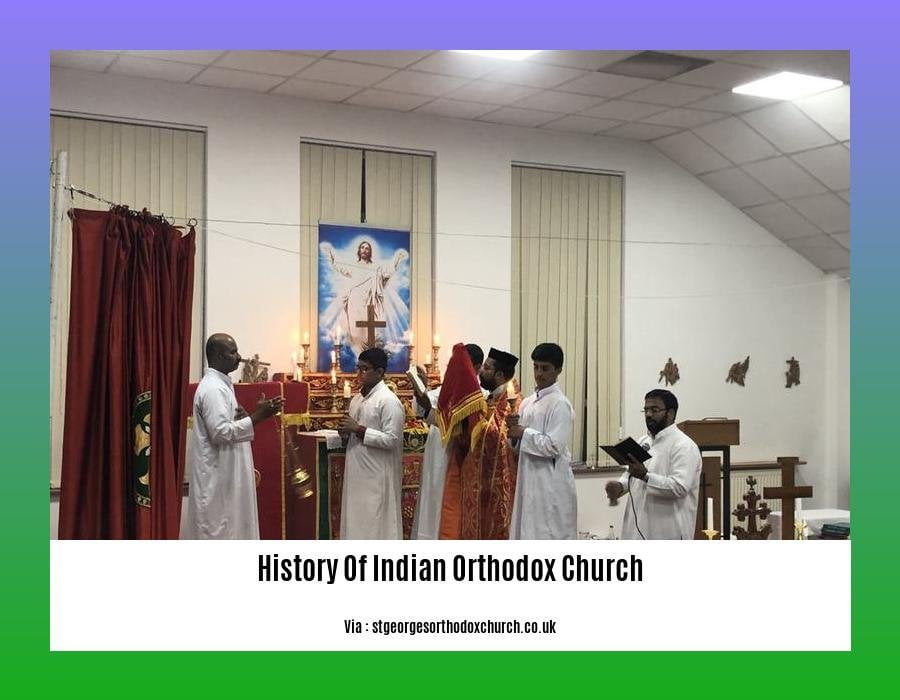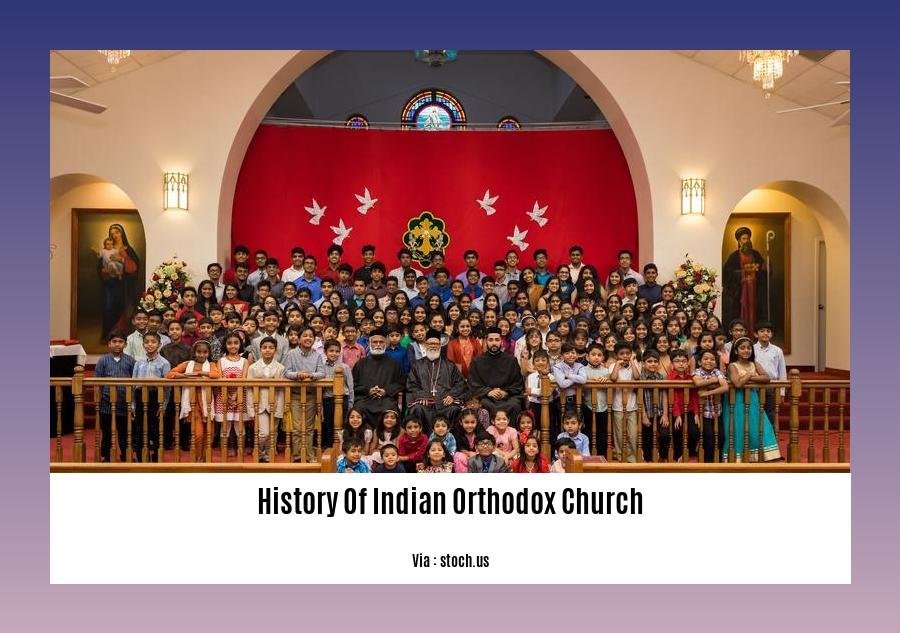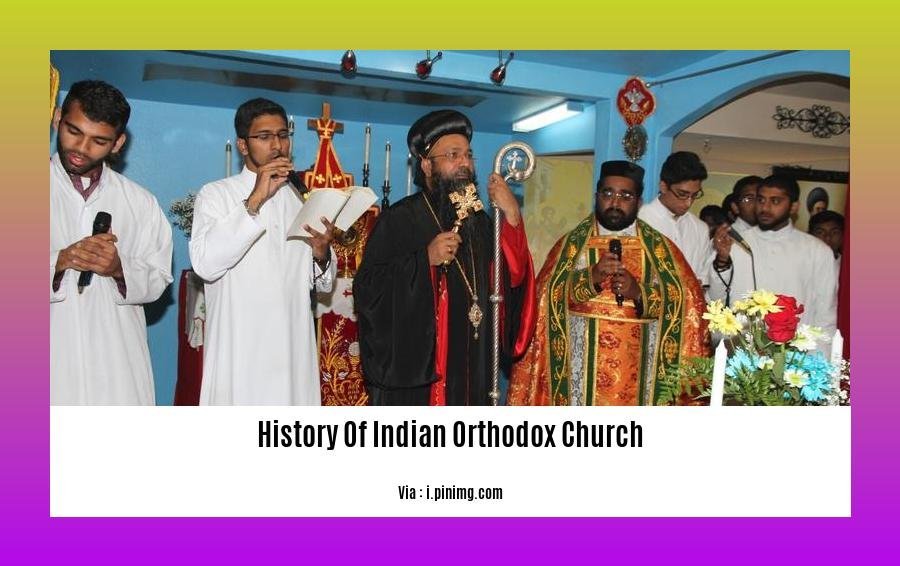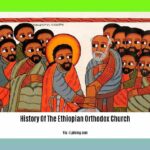Embark on a journey through time as we unveil the rich history of the Indian Orthodox Church in our article, “Unveiling the History of Indian Orthodox Church: Tracing the Ecclesiastical Legacy of Saint Thomas Christians.” Delve into the depths of this ancient Christian tradition, tracing its apostolic roots and exploring its profound impact on the socio-cultural fabric of India and beyond. Join us as we uncover the unique rituals, theological nuances, and historical milestones that have shaped this enduring faith community.
Key Takeaways:
The Malankara Orthodox Syrian Church (MOSC) traces its origins to Thomas the Apostle, who is believed to have brought Christianity to India in the 1st century AD.
The MOSC is an autocephalous church, meaning it is self-governing and independent of any external ecclesiastical authority.
The spiritual head of the church is the Catholicos of the East, while the temporal head is the Malankara Metropolitan.
The church follows the Malankara Rite, which is part of the Antiochene Rite.
Until the 17th century, the church was administered by an archdeacon (Malankara Moopan), responsible for day-to-day affairs.
History of Indian Orthodox Church

Christianity, like many facets of Indian culture, boasts a rich and diverse history. Let’s delve into the tapestry of the Indian Orthodox Church, exploring its apostolic origins and the indelible imprint it has left on the socio-cultural landscape of the nation.
Apostolic Roots:
- The Indian Orthodox Church, also known as the Malankara Orthodox Syrian Church, traces its lineage back to Saint Thomas the Apostle, who is believed to have brought the teachings of Christ to the shores of India in the 1st century AD.
- Saint Thomas’s arrival in India marks the dawn of Christianity in the region, laying the foundation for a vibrant and enduring Christian community that has stood the test of time.
Autocephalous Status and Governance:
- The Indian Orthodox Church enjoys the status of autocephaly, which means it is self-governing and independent of any external ecclesiastical authority.
- The spiritual leadership of the church is vested in the Catholicos of the East, while the temporal administration is headed by the Malankara Metropolitan.
- This unique governance structure allows the church to maintain its autonomy and preserve its distinct cultural and liturgical traditions.
Liturgical Traditions and Practices:
- The Indian Orthodox Church adheres to the Malankara Rite, a variant of the Antiochene Rite, which is characterized by its rich symbolism and deep reverence for ancient liturgical practices.
- The church’s liturgy is conducted in a blend of Syriac and Malayalam, reflecting the diverse linguistic heritage of its faithful.
- These liturgical traditions, passed down through generations, serve as a testament to the church’s commitment to preserving its unique identity and heritage.
Historical Milestones:
- The 17th century marked a significant turning point in the history of the Indian Orthodox Church, with the appointment of an archdeacon, known as the Malankara Moopan, to oversee the day-to-day affairs of the church.
- This appointment marked a shift in the church’s administrative structure and laid the foundation for a more centralized leadership.
- The church has since navigated numerous challenges and triumphs, emerging as a resilient and influential force in the religious landscape of India.
Legacy and Enduring Influence:
- Over the centuries, the Indian Orthodox Church has played a pivotal role in shaping the cultural and social fabric of India.
- Its educational institutions, charitable organizations, and community outreach programs have positively impacted countless lives, promoting education, healthcare, and social welfare.
- The church’s dedication to interfaith dialogue and collaboration has fostered a spirit of understanding and harmony among different religious communities in India.
Want to know about the city of Ibadan’s history? Dive deep into the city’s past here.
Explore the historical evolution of Indian clothing here.
Get to know the history behind the vibrant Indian costumes here.
Learn about the history of Indian Motorcycle Company here.
The church faced significant challenges during the colonial period, including persecution and attempts to Latinize its traditions. However, it maintained its autonomy and distinct identity.

Amidst the tumultuous waves of colonialism, the Indian Orthodox Church valiantly weathered storms of persecution and assimilation attempts. The colonial era, characterized by European dominance, posed formidable challenges to the church’s autonomy and unique traditions.
Persecution and Latinization Endeavors:
During the colonial period, the Indian Orthodox Church faced relentless persecution and concerted efforts to Latinize its distinctive traditions. The colonial powers sought to impose their religious and cultural norms, aiming to dilute the church’s rich heritage.
Persecution: The church endured waves of persecution, with its members subjected to imprisonment, torture, and even martyrdom. Colonial authorities sought to suppress the church’s practices and curtail its influence within Indian society.
Latinization Attempts: A concerted effort was made to Latinize the church’s liturgy, rituals, and practices, aligning them with those of the Roman Catholic Church. This assimilation drive aimed to undermine the church’s unique identity and bring it under the control of the Catholic hierarchy.
Preserving Autonomy and Distinctive Identity:
Despite these challenges, the Indian Orthodox Church steadfastly preserved its autonomy and distinctive identity. Through the unwavering resilience of its faithful and the astute leadership of its hierarchy, the church successfully navigated the turbulent waters of colonialism.
Unwavering Resilience: The faithful remained steadfast in their devotion, refusing to succumb to external pressures. Their unwavering resilience served as a bulwark against attempts to dismantle the church’s unique traditions.
Astute Leadership: The church’s leadership exhibited remarkable foresight and diplomatic skills. They skillfully negotiated with colonial authorities, safeguarding the church’s autonomy while maintaining a spirit of dialogue and cooperation.
Legacy of Perseverance:
The legacy of the Indian Orthodox Church during the colonial period stands as a testament to its unwavering commitment to preserving its unique identity and autonomy. The church’s resilience in the face of adversity serves as an inspiration to future generations, demonstrating the power of faith and unity in overcoming challenges.
Key Takeaways:
Colonial Era Challenges: The church faced significant challenges during the colonial period, including persecution and attempts to Latinize its traditions.
Persecution: The colonial authorities persecuted the church’s members, suppressing their practices and influence.
Latinization Attempts: Efforts were made to assimilate the church’s liturgy and practices with those of the Roman Catholic Church.
Preserving Identity: Despite these challenges, the church maintained its autonomy and distinctive identity through the resilience of its faithful and the astute leadership of its hierarchy.
Legacy of Perseverance: The church’s legacy during this period exemplifies its commitment to preserving its unique traditions and autonomy, inspiring future generations.
Sources:
- The Indian Orthodox Church During the Colonial Period
- The Latinization of the Indian Orthodox Church
In the 19th century, a major schism within the church led to the formation of the Jacobite Syrian Orthodox Church, resulting in two separate but closely related denominations.
Divisions and schisms have been an unfortunate part of the Christian Church’s history. In the 19th century, the Indian Orthodox Church experienced a significant split that resulted in the formation of the Jacobite Syrian Orthodox Church. Let’s explore the factors that led to this schism and its impact on the Indian Christian community.
Factors Leading to the Schism:
- Disagreements over the Patriarchal Succession: A dispute arose over the succession of the Patriarch of Antioch, the head of the Syrian Orthodox Church. Two rival patriarchs emerged, each claiming legitimacy, leading to confusion and division within the church.
- Influence of Outside Forces: External political and religious influences, particularly from the British colonial administration and other Christian denominations, played a role in fueling tensions within the church.
- Internal Conflicts: Internal power struggles, personality clashes, and theological differences among church leaders contributed to the growing rift.
Formation of the Jacobite Syrian Orthodox Church:
In 1876, a group of dissident clergy and laity, led by Pulikottil Joseph Dionysius, broke away from the Indian Orthodox Church and formed the Jacobite Syrian Orthodox Church. They aligned themselves with the Jacobite Patriarch of Antioch, who supported their cause.
Consequences of the Schism:
- Two Separate Denominations: The schism resulted in the creation of two distinct denominations within the Indian Christian community, each with its own hierarchy, rituals, and theological interpretations.
- Legal Battles: The division led to legal battles over church properties and assets, further straining the relationship between the two factions.
- Ecclesiastical Rivalry: The schism created a sense of rivalry and competition between the Indian Orthodox Church and the Jacobite Syrian Orthodox Church, affecting inter-church relations and cooperation.
Key Takeaways:
- The 19th-century schism in the Indian Orthodox Church led to the formation of the Jacobite Syrian Orthodox Church.
- Disputes over patriarchal succession, external influences, and internal conflicts contributed to the split.
- The schism resulted in two separate denominations with distinct hierarchies, rituals, and theological perspectives.
- Legal battles over church properties and ecclesiastical rivalry further strained the relationship between the two factions.
Sources:
In the Present Day, the Indian Orthodox Church: A Thriving Global Community
The Indian Orthodox Church, rooted in ancient traditions and a rich heritage, stands tall today as a dynamic and growing community of believers. Its presence extends far beyond the borders of India, reaching across the globe with dioceses established in the Middle East, Europe, and North America. This vibrant church remains steadfast in its commitment to preserving its ancient heritage while simultaneously embracing contemporary issues, fostering growth and relevance in the modern world.
Key Takeaways:
- The Indian Orthodox Church, founded in 1912, traces its origins to Saint Thomas the Apostle, who brought Christianity to India.
- Headquartered in Devalokam, near Kottayam, the church serves Saint Thomas Christians, descendants of the apostle’s devoted followers.
- With its strong commitment to preserving its rich heritage, the Indian Orthodox Church adheres to the Malankara Rite, a unique variant of the Antiochene Rite, conducting its liturgy in a harmonious blend of Syriac and Malayalam.
- The church’s spiritual leadership is vested in the Catholicos of the East, while temporal administration is guided by the Malankara Metropolitan, ensuring ecclesiastical harmony and effective governance.
- The Indian Orthodox Church actively engages with contemporary issues, promoting interfaith dialogue, fostering understanding and harmony among diverse religious communities, and contributing to social welfare through educational institutions, charitable organizations, and community outreach programs.
The Indian Orthodox Church stands as a testament to the enduring legacy of Saint Thomas, whose teachings continue to inspire and guide its faithful. Its global presence and commitment to preserving its ancient heritage, while simultaneously embracing contemporary issues, make it a beacon of faith and a significant contributor to the diverse tapestry of Christianity worldwide.
Relevant Sources:
- Spotlight on the Eastern Churches: The Indian Orthodox Church | CNEWA
- History of Indian Orthodox Church | St. Thomas Orthodox Church of Detroit
FAQ
Q1: When was the Indian Orthodox Church founded?
A1: The Indian Orthodox Church was founded in 1912 following a schism within the Malankara Syrian Orthodox (Jacobite) Church.
Q2: What is the significance of Saint Thomas the Apostle to the Indian Orthodox Church?
A2: Saint Thomas the Apostle is believed to have brought Christianity to India in the 1st century AD, and the Indian Orthodox Church claims to be one of the 37 Apostolic Churches originating during this period.
Q3: Where is the headquarters of the Indian Orthodox Church located?
A3: The headquarters of the Indian Orthodox Church is situated in Devalokam, near Kottayam, India.
Q4: What is the liturgical tradition of the Indian Orthodox Church?
A4: The Indian Orthodox Church follows the Malankara Rite, a variant of the Antiochian Rite.
Q5: What is the size of the Indian Orthodox Church?
A5: The Indian Orthodox Church is estimated to have over 2 million adherents primarily concentrated in India, particularly among the Saint Thomas Christian population.
- Who Owns Mercedes Cars? 2025 Update: Unveiling the Shareholders - May 6, 2025
- UAE Federal National Council: Evolution of Participation - May 6, 2025
- Trump’s 2025 Portrait: Unveiled, Analyzed - May 6, 2025
















